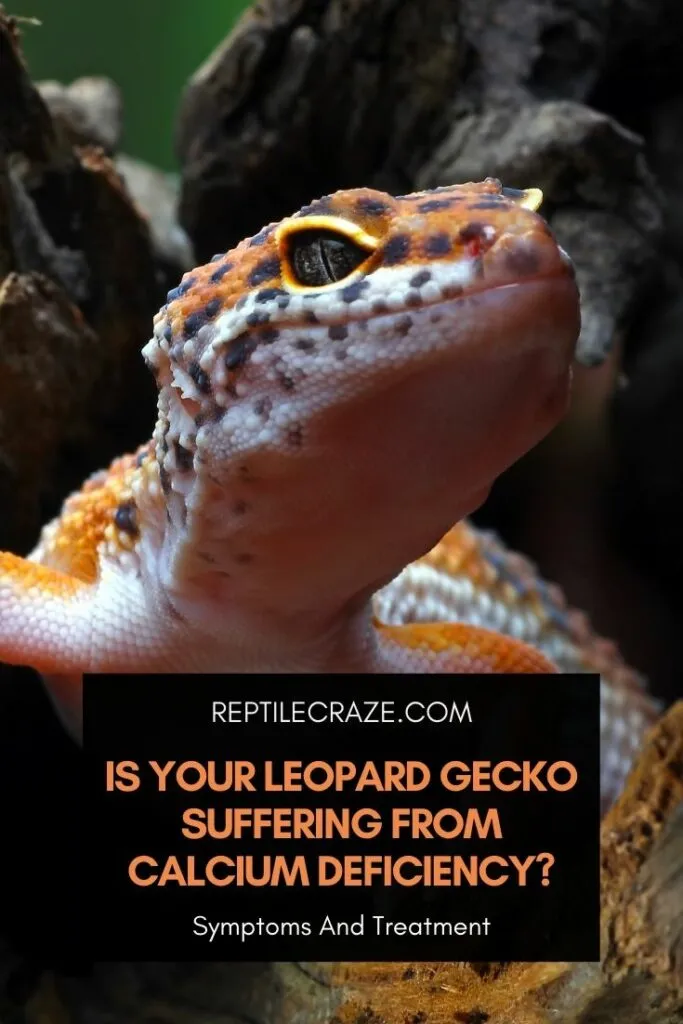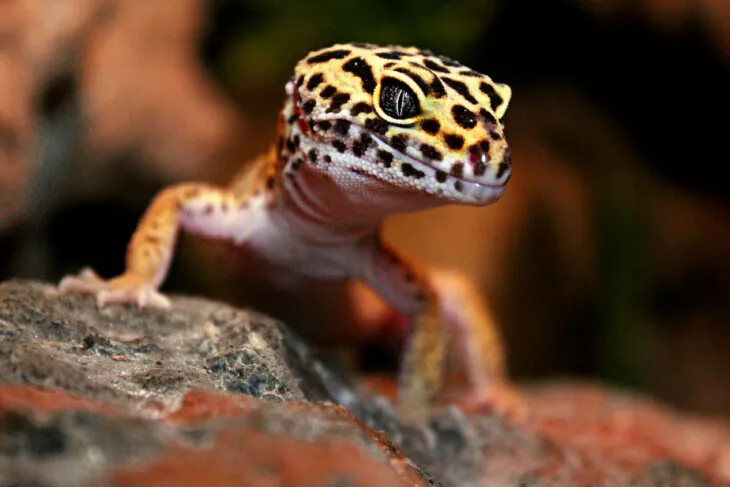
Leopard Geckos living in the wild always pick out
When Leopard Gecko shows signs of lethargy, loses appetite, and has no strength to catch prey, you should suspect it suffers from calcium deficiency. More severe symptoms include swollen and deformed limbs, flexible bones, crooked back and legs, and soft facial bones, which require visiting a vet.
This article will show the typical causes and symptoms of calcium deficiencies in Leopard Geckos, the best prevention, and ways of efficient treatment.
Table of Contents
Leopard Gecko Calcium Deficiency Symptoms
Calcium deficiency symptoms in Leopard Geckos are not specific in the very beginning. However, unusual behavior and swollen limbs should be an alert that something is wrong.
The most common symptoms you should pay attention to include:
- Lethargy, low energy, and loss of appetite
- Swollen, deformed, flexible, and crooked limbs
- Soft facial bones, particularly jaw
- Crooked back
- Tail thinning and twitched toes
- Impossibility to raise belly off the ground
- Shaky movements while walking and coordination issue
- Difficulty catching prey
- Tendency to bone bending and fracture
- Paralysis
The crucial thing is to react on time and ask your vet for advice as soon as the first symptoms occur. That way, your Leo will have a better chance to entirely recover and survive.
Leopard Gecko Calcium Deficiency Treatment
As always, prevention is the best option you have, particularly for such an easily preventable disease. Luckily, it is possible helping your Leopard Gecko even when calcium deficiency occurs. There are a few simple options you can apply on your own.
Since their diet often lacks calcium, that is the first thing to check. Otherwise, your Gecko can face severe metabolic bone disease and further complications of its health condition.
| Insects rich in calcium | Life stage | Ca | P |
| Soldier Flies | larvae | 9,340 mg/kg | 3,560 mg/kg |
| Madagascar hissing cockroaches | nymphs | 771 mg/kg | 2,870 mg/kg |
| Fruit flies | adults | 526 mg/kg | 4,080 mg/kg |
| House crickets | adult | 407 mg/kg | 2,950 mg/kg |
| Turkestan roaches | nymphs | 385 mg/kg | 1,760 mg/kg |
| Cockroaches | nymphs | 295 mg/kg | 1,820 mg/kg |
| House crickets | nymph | 275 mg/kg | 2,520 mg/kg |
| Waxworms | larvae | 243 mg/kg | 1,950 mg/kg |
| Silkworms | larvae | 177 mg/kg | 2,370 mg/kg |
| Superworms | larvae | 177 mg/kg | 2,370 mg/kg |
| Mealworms | larvae | 169 mg/kg | 2,850 mg/kg |
| Butterworms | larvae | 125 mg/kg | 2,250 mg/kg |
| Hornworms | adult | 464 mg/kg | 1,394 mg/kg |
Black soldier fly larvae
Feeding your Leopard Gecko with these larvae seems an excellent idea. They are packed with calcium and phosphorus and have an acceptable Ca: P ratio, excluding the necessity of gut loading.
Unfortunately, recent studies show a limited calcium digestibility coming from these larvae of only 43%.
Enrich food with calcium
Commercially raised insects are a typical option for feeding insectivorous reptiles, including Leopard Geckos. However, the calcium level they contain depends on their own diet, affecting the amount of this mineral your Leo gets.
The best possible approach when noticing the first symptoms of calcium deficiency is to gut load feeder insects, like:
- Crickets
- Locusts
- Super worms
- Mealworms
- Dubia roaches
- Hissing cockroaches
Dusting insects with calcium supplements will provide enough of this mineral necessary for your Gecko’s healthy development. The recommendation is to add them at least a day before feeding.
Mark Finke LLC MS, Ph.D. published a scientific paper, Insects as Food for Insectivores, 17.7.1 Gut Loading, with recommendations for adding calcium to the reptile diet.
He concluded that it is necessary to gut load insects with 3 to 9% elemental calcium, depending on the species you offer to your Gecko.
Calcium supplements
In this case, the recommended approach is to offer specific powdered supplements to your Leo directly. The rule of thumb is to provide calcium separately from other mineral supplements.
The reason is that regular lizard
However, some owners find this method unreliable because Geckos often refuse to eat tasteless calcium powder. Even if the lizard decides to consume it, there is no way to control the amount of ingested mineral.

Calcium to phosphorus ratio
Besides the fact that most feeders you can offer your Leopard Gecko are deficient in calcium, many additionally contain excessive phosphorus levels.
Keep in mind that only
Multivitamins and UVB lighting
It is not enough to offer calcium to your Gecko. You should be aware that without vitamin D3, it won’t be able to absorb this mineral from
One of the solutions is to offer your Leo a multivitamin containing both calcium and vitamin D3. Such a product will provide a balanced ratio of these ingredients, and you will have full control over these nutrients intake.
Some experts recommend UVB lighting as necessary for keeping your Leo healthy. However, it is a bit questionable since generations of Leopard Geckos lived in captivity without lamps providing this light type.
Tip: Check out our article on the best vitamins for leopard geckos (with vitamin schedule) here!
Signs of Leopard Gecko’s Metabolic Bone Disease
Metabolic bone disease is an incurable, painful, and often lethal condition of neglect. It occurs when Leopard Gecko suffers from long-lasting insufficient calcium intake.
This condition is pretty standard in reptiles, including Geckos, Iguanas, and Bearded Dragons.
In her book, Biology and Diseases of Reptiles, Chapter 18, Dorcas P. O’Rourke states that the most often endangered are juvenile lizards.
The primary factor that causes MBD in Leopard Geckos is a lack of calcium and is almost always connected to its feeding habits.
In other words, if you feed your Leo properly and do not neglect it, there is little chance for this disease to occur.
| Mineral | Gender | Value |
| Calcium | female | 12 to 20+ mg/dL (3 – 5 mmol/L) |
| Calcium | male | 11.7 to 14.4 mg/dL (3 – 3.6 mmol/L) |
| Phosphorus | female | 3.8 to 18.8 mg/dL (1 – 4.7 mmol/L) |
| Phosphorus | male | 2.6 to 6.2 mg/dL (0.6 – 1.5 mmol/L) |
In rare cases, your Gecko’s body can have a problem with using and metabolizing this essential mineral. In this case, it can get sick despite a calcium-rich diet. The typical reasons for metabolic bone disease to occur in Leopard Geckos are:
- Low calcium levels in a diet
- Hyperphosphataemia and calcium-to-phosphorus imbalance
- Insufficient exposure to UV rays
- Lack of vitamin D3
- Temperatures in a terrarium under 90 F (32.2 C)
You should know that hypocalcemia will force the Gecko’s body to use calcium from its own bones. As a result, it will systematically weaken them, negatively affecting reproduction and lowering metabolism until the horrible end.
Typical symptoms that should warn you of the metabolic bone disease include:
- Tiredness
- Loss of appetite and weight loss despite regular feeding
- Improperly closed and swollen jaws
- Bone deformities and limping
- Body shivering
- Bowed legs
- Seizures and paralysis
Unfortunately, metabolic bone disease can kill your Leopard Gecko within a year if you fail to react as soon as the first symptoms appear.
In most cases, the only way to keep your pet healthy is to include adequate
Metabolic Bone Disease Leopard Gecko Treatment
You should be aware that metabolic bone disease is a partially reversible condition but often incurable in neglected cases. The crucial problem is the slow disease progress without showing typical symptoms for a long.
Once the Gecko manifests typical MBD symptoms, it may be too late. That is why prevention and regular checking of your pet’s condition is of vital importance.
If you detect the disease’s development at a time when your Leopard Gecko faces only mild MBD symptoms, you can treat it at home. The best options you have are:
Gut loading
The first step is to gut load insects you want to offer your Leo. It is a way of enriching
You can simply dust chosen insects with this mineral before releasing them into the terrarium.
UVB lighting
This lighting may help your Gecko’s body produce vitamin D3 on its own and increase calcium absorption. Ideally, you should expose it to approximately 5% to 7% output of UVB rays at least 12 to 14 hours a day.
On the other hand, D.G.A.B. Oonincx from the Department of Animal Sciences, Wageningen, the Netherland, represented his research on the subject.
His results show that a diet poor in calcium is a more significant problem when it comes to MBD than lighting.
In other words, multivitamins are a more effective solution for preventing this dangerous lizard disease, regardless of the UV rays’ importance level. Remember that glass, metal, plastic, and plexiglass prevent these rays from reaching the lizard.

Pure calcium
Putting grated cuttlebone inside the terrarium means offering your Leo the purest calcium source. The problem with this method is that lizards sometimes don’t like this feeder’s taste.
Visit your vet
The best thing to do when noticing the first symptoms of MBD is to ask your vet for help. It becomes required if your Leo doesn’t respond to the treatment you have undertaken and there is no improvement after a month.
Unfortunately, Leopard Geckos have no endolymphatic sacs necessary for calcium storage, unlike other reptiles. Therefore, it is impossible to diagnose MBD by checking its calcium reserves.
Keep in mind that adequately fed Leos won’t suffer from this condition, so prevention is the key. That makes you a key factor that will make a difference.
Summary
A few factors play a role in your Leopard Gecko’s problems with calcium deficiency. Besides this mineral’s absorption disorder, its intake in recommended amount is crucial.
In other words, there is a low chance that your Leo will get sick if you take care of his proper diet and sufficient calcium intake.
Plus, it is necessary to consider the ratio of this mineral with phosphorus and provide enough vitamin D3 essential for calcium absorption.
- Enchi Ball Python: A Unique and Stunning Morph of Python regius - March 27, 2025
- Emerald Tree Monitor: The Enigmatic Green Guardian of the Rainforest - March 26, 2025
- The Egyptian Cobra (Naja haje): A Fascinating Serpent - March 25, 2025
